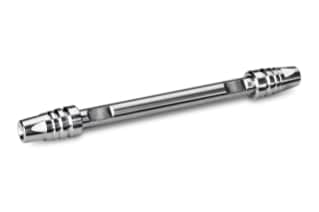
|
Chemistry |
C18 |
|
Separation Mode |
Reversed Phase |
|
Particle Substrate |
Hybrid |
|
pH Range Min |
2 pH |
|
pH Range Max |
11 pH |
|
Maximum Pressure |
10000 psi (690 Bar) |
|
Endcapped |
Yes |
|
Bonding Technology |
Shield RP18 |
|
Silanol Activity |
Low |
|
Particle Shape |
Spherical |
|
Particle Size |
2.5 µm |
|
Endfitting Type |
Parker-style |
|
Pore Size |
130 Å |
|
Format |
Column |
|
Surface Area |
185 |
|
System |
UPLC, UHPLC |
|
Particle Technology |
BEH |
|
USP Classification |
L1 |
|
Inner Diameter |
4.6 mm |
|
Length |
100 mm |
|
Carbon Load |
17 % |
|
UNSPSC |
41115709 |
|
Brand |
XBridge |
|
Product Type |
Columns |
|
Units per Package |
1 pk |

XBridge BEH Shield RP18 XP Column, 130Å, 2.5 µm, 4.6 mm X 100 mm, 1/pk
To reach outstanding bases, the XBridge BEH Shield RP18 XP Column is an ideal choice. Because of the incorporated Shield Technology, the XBridge BEH Shield RP18 XP Column has fewer silanol interactions with basic analytes. This method creates a shielding effect in the sample, which helps to deliver extremely symmetrical and efficient peak geometries and peaks by deactivating interactions with basic analytes. Other typical C18 columns, on the other hand, have poor peak symmetry due to secondary interactions with basic chemicals caused by weak cation exchange with residual surface silanols.
The XBridge BEH Shield RP18 XP Column was created to complement existing XBridge offers, such as the XBridge BEH C18 and C8 phase, and to serve as a useful tool for the HPLC method development. In contrast to normal straight-chain alkyl columns, the carbamate group in the bonded phase ligand gives alternate selectivity, especially for phenolic chemicals, in the XBridge BEH Shield RP18 XP Column.
The eXtended Performance (XP) ultra-low dispersion technology in the XBridge BEH Shield RP18 XP Column enables the column to give superior separation performance, resilience, and throughput for HPLC tests while allowing for a smooth transition to UPLC adoption.
The right lab equipment will enable you to increase your productivity and efficiency. To review the additional lab equipment offerings from Waters, such as the XBridge BEH Shield RP18 XP Column, or to find additional products that are compatible with it, check out our shop for lab equipment; you can browse through our website, refer to our catalog and ensure your lab needs are met as needed.
You may also be interested in reviewing the XBridge BEH Shield RP18 XP VanGuard Cartridge, 130Å, 2.5 µm, 3.9 mm X 5 mm, 3/pk; XBridge BEH Shield RP18 VanGuard Cartridges are used to extend analytical column lifetime and performance by removing particulate contamination from the mobile phase stream. This cartridge is optimized to protect all 4.6 mm I.D. XBridge BEH Shield RP18 analytical columns containing 2.5 µm sorbent particles.
What Is The Meaning Of The Word "Elution" Within Liquid Chromatography?
Elution, in chromatography, refers to the process of extracting a substance adsorbed on a solid adsorbent by using a solvent or the dissociation of an antibody from its attached antigen. The eluent, also known as the eluant, acts as the carrier component of the mobile phase, facilitating the transportation of analytes through the chromatographic system during this process.